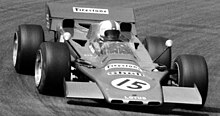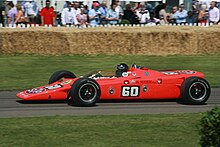Lotus 56
This article needs additional citations for verification. (June 2018) |
 Dave Walker in the 56B at Zandvoort | |||||||||
| Category | Formula One USAC IndyCar | ||||||||
|---|---|---|---|---|---|---|---|---|---|
| Constructor | |||||||||
| Designer(s) | Colin Chapman (Technical Director) Maurice Philippe (Chief Designer) | ||||||||
| Predecessor | 72 (F1) 42 (USAC IndyCar) | ||||||||
| Successor | 72 (F1) 64 (USAC IndyCar) | ||||||||
| Technical specifications | |||||||||
| Chassis | Aluminium monocoque | ||||||||
| Suspension (front) | Double wishbones, inboard coil springs over dampers | ||||||||
| Suspension (rear) | Double wishbones, inboard coil springs over dampers | ||||||||
| Engine | Pratt & Whitney STN76[1] gas turbine mid-mounted | ||||||||
| Transmission | No gearbox or clutch[2] Four-wheel drive | ||||||||
| Power | 500–600 hp (373–447 kW)[3][4] | ||||||||
| Weight | 612kg (USAC IndyCar) 600kg (F1) | ||||||||
| Fuel | STP (USAC IndyCar) Shell (F1) | ||||||||
| Tyres | Firestone | ||||||||
| Competition history | |||||||||
| Notable entrants | Gold Leaf Team Lotus (F1) World Wide Racing (F1) | ||||||||
| Notable drivers | |||||||||
| Debut | 1968 Indianapolis 500 (USAC IndyCar) 1971 Dutch Grand Prix (F1) | ||||||||
| |||||||||
| n.b. Unless otherwise stated, all data refer to Formula One World Championship Grands Prix only. | |||||||||
The Lotus 56 was a gas turbine-powered four-wheel-driven racing car, designed by Maurice Philippe as Team Lotus's 1968 STP-backed entry in the Indianapolis 500, replacing the successful Lotus 38 and the 1967 STP-Paxton Turbocar. The 4WD concept was also used in the 1969 Lotus 63 F1 car, and the wedge shape became a prominent feature of the world championships winning Lotus 72. As Lotus 56B, a modified version designed by Maurice Philippe and Colin Chapman, the gas turbine car returned in Gold Leaf colours at a few 1971 Formula One events.
Indy 500[]


The Lotus 56 used a modified version of the ST6 gas turbine used on the STP-Paxton Turbocar ("Silent Sam") that almost won in 1967. The ST6 was based on a small aircraft engine that became one of the most popular turboprop aircraft engines in history. But the car itself was an entirely new and more advanced design which introduced a distinctive aerodynamic wedge-shaped body rather than a cigar-shape, in the year of the introduction of front and rear wings to F1.[5] USAC, the governing body of the Indy 500, had implemented new rules aimed at handicapping turbine powered racing cars by drastically reducing the air intake size. The Lotus 56 made up for reduced power with a sophisticated suspension design, retaining the four-wheel drive concept of the Silent Sam, but with lighter weight, and advanced aerodynamics.
Lotus had suffered the death of driver Jim Clark in a Formula 2 race in Germany. Mike Spence was killed at Indianapolis while testing one of four 56s built. The remaining three cars with Graham Hill, Joe Leonard, and Art Pollard were entered for the race, with Leonard claiming pole position. Unlike the year before, when the STP-Paxton Turbocar easily outperformed the other cars in the race, in the race the turbine cars were relatively evenly matched with the other top contenders, much of which must be attributed to aerodynamics and chassis design and not to the turbine engine. Hill's car crashed, Pollard's car broke down, while Leonard was leading with just a handful of laps to go when the a fuel pump shaft failed. Shortly thereafter, the USAC imposed additional restrictions on turbine cars that essentially removed them from competition. For the second year in a row STP turbine cars had brought innovation to the Indy 500 and had failed to win while leading within a few laps of the end of the race. USAC subsequently banned turbine cars and four-wheel drive completely, but it was unusual enough that Mattel produced a model of the "Lotus Turbine" as one of the popular mass-produced die cast Hot Wheels cars.
In 1969, Art Pollard brought an Offenhauser-powered Lotus 56 to Indy.
In 1971 the Lotus 56 was raced in Formula 1 on occasion by Team Lotus but the large fuel tanks required to allow it to run an entire race without refuelling left it overweight and uncompetitive. Lotus also developed a "widebody" 56B for Formula 1, with revised "big wedge" aerodynamics.
The Lotus 56, while never winning a race, demonstrated the importance of aerodynamics in racing cars, along with Jim Hall's Chaparrals, and effectively set the mould for open-wheeled racing cars for the next ten years. Chapman's Lotus 72 employed the same wedge nose shape and went on to win three world championships in Formula 1.
Formula One[]
Colin Chapman developed the 56 as a potential F1 contender, part of his plan to have a single design to compete at both the Indy 500 and in Formula 1, but it was too heavy and never competitive. The car was designated as the 56B and Emerson Fittipaldi tried it in the 1971 Race of Champions and International Trophy non-Championship meetings. At Brands Hatch, during wet practice, the 56 was far and away the fastest car on the track, but the race was held in dry weather and the car was lost in midfield. At the Silverstone-based International Trophy, the car only lasted three laps of the first heat before suspension failure forced Fittipaldi's retirement. Dave Walker ran the car in the Dutch Grand Prix, and had progressed from 22nd to 10th in five laps of the very wet track, before sliding off the road and into retirement. Fittipaldi used the car again in that year's 1971 Italian Grand Prix and managed to bring the fragile design home 8th.
Formula One World Championship results[]
(key)
| Year | Entrant | Engine | Tyres | Driver | 1 | 2 | 3 | 4 | 5 | 6 | 7 | 8 | 9 | 10 | 11 | WCC | Pts. |
|---|---|---|---|---|---|---|---|---|---|---|---|---|---|---|---|---|---|
| 1971 | Gold Leaf Team Lotus World Wide Racing |
Pratt & Whitney ST6 gas turbine |
F | RSA | ESP | MON | NED | FRA | GBR | GER | AUT | ITA | CAN | USA | 0 | NC | |
| Dave Walker | Ret | ||||||||||||||||
| Reine Wisell | NC | ||||||||||||||||
| Emerson Fittipaldi | 8 |
Formula One non-championship results[]
(key) (Races in bold indicate pole position) (Races in italics indicate fastest lap)
| Year | Entrant | Tyres | Driver | 1 | 2 | 3 | 4 | 5 | 6 | 7 | 8 |
|---|---|---|---|---|---|---|---|---|---|---|---|
| 1971 | Gold Leaf Team Lotus | F | ARG | ROC | QUE | SPR | INT | RIN | OUL | VIC | |
| Emerson Fittipaldi | Ret | Ret | |||||||||
| Reine Wisell | Ret | ||||||||||
| Dave Walker | PO |
See also[]
References[]
| Wikimedia Commons has media related to Lotus 56. |
- 1971 Formula One season cars
- Lotus Formula One cars
- American Championship racing cars
- Cars powered by gas turbines
- All-wheel-drive vehicles